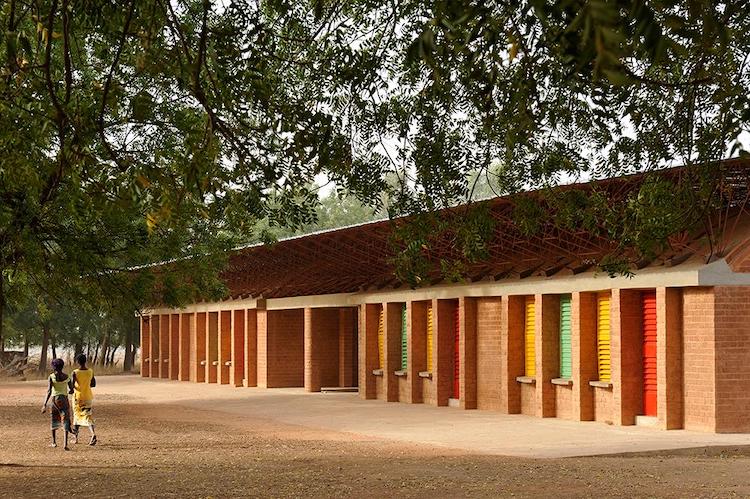
2022 Pritzker Architecture Prize Winner, Diébédo Francis Kéré. (Photo: Lars Borges, courtesy of The Pritzker Architecture Prize)
In the world of architecture, the Pritzker Architecture Prize is considered the profession’s highest honor. It is sometimes even referred to as “architecture’s Nobel,” awarded for significant achievement to living architects whose work “has produced consistent and significant contributions to humanity and the built environment.” Receiving an award of such high esteem would be an honor for anyone, but this year’s Pritzker Prize Laureate is also making history as the first Black man and the first African architect to receive the prestigious prize.
The pioneering honoree, Diébédo Francis Kéré (known professionally as Francis Kéré) was born in Burkina Faso—a country in West Africa whose name means “land of the upright [honest] people.” Though there was no school in his small village of Gando, Kéré’s parents insisted that their son be educated. This eventually led him to study in Berlin on a carpentry scholarship and later pursue an advanced degree in architecture.
Although he left his country to pursue higher education, Kéré’s heart was never far from his homeland. In fact, his experiences growing up in Gando from childhood have influenced every facet of his architectural practice from the outset. “I grew up in a community where there was no kindergarten, but where community was your family,” Kéré recalls. “Everyone took care of you and the entire village was your playground. My days were filled with securing food and water, but also simply being together, talking together, building houses together. I remember the room where my grandmother would sit and tell stories with a little light, while we would huddle close to each other and her voice inside the room enclosed us, summoning us to come closer and form a safe place. This was my first sense of architecture.”
Unlike the usual celebrity “starchitects” that the Pritzker has generally been awarded to until now, Kéré has been much lesser-known. His signature buildings include structures like primary schools and healthcare facilities built back in his homeland of Burkina Faso and surrounding regions. Influenced by his childhood memories of studying for hours at a time in extreme temperatures—often over 100 degrees Fahrenheit—trapped in small classrooms with poor ventilation and little light, he has always directed his professional output towards bettering those conditions.

Benga Riverside School (2018); Tete, Mozambique. (Photo: Francis Kéré, courtesy of The Pritzker Architecture Prize)
Kéré’s innovative design for his first professional project, Gando Primary School, combined the sustainable use of indigenous materials with modern engineering to produce a structure “built by and for the people of Gando.” The success of this endeavor earned him the Aga Khan Award for Architecture in 2004 and allowed him to establish his own architecture firm in Berlin called Kéré Architecture, which is why he appreciates the role his community had in helping him reach this height of success. “This is not just a prize for myself,” Kéré relates. “Without having the courage to go back home, and to get my people to join me on the journey to build the school that (launched) my career, this would never have been possible.”
In addition to schools built in Burkina Faso and other regions in Africa, Kéré’s work has expanded to include both temporary and permanent structures throughout the world, including Denmark, Germany, Italy, Switzerland, and the United States. He was even commissioned to design London’s Serpentine Pavilion in 2017, creating an imaginative structure whose shape recalls that of a tree. In recent years, Kéré has been commissioned to design the new National Assembly buildings in Burkina Faso and neighboring Benin. The Benin National Assembly is currently under construction, and its design also draws inspiration from the symbolic palaver tree which stands as “a powerful landmark and communal space for many African communities.”
With the award of the Pritzker Prize, Kéré will also receive a bronze medallion and a $100,000 grant. His sustainable approach and focus on community within his architectural practice have earned him a spot amongst the most celebrated architects in the world. And as the first Black man to receive such an honor, Kéré’s legacy will continue to inspire change and innovation in the field for years to come.
“Since the world began to pay attention to the remarkable work and life story of Francis Kéré, he has served as a singular beacon in architecture,” states the 2022 Pritzker Prize Jury Citation. “He has shown us how architecture today can reflect and serve needs, including the aesthetic needs, of peoples throughout the world. He has shown us how locality becomes a universal possibility. In a world in crisis, amidst changing values and generations, he reminds us of what has been, and will undoubtedly continue to be a cornerstone of architectural practice: a sense of community and narrative quality, which he himself is so able to recount with compassion and pride.”
Diébédo Francis Kéré has been announced as the first Black man and the first African architect to be awarded the Pritzker Architecture Prize, also known as “architecture's Nobel.”
Kéré's career took off with his innovative designs that bettered the conditions in schools throughout his home country, Burkina Faso, and surrounding regions.

Gando Primary School (2001); Gando, Burkina Faso. (Photo: Erik-Jan Owerkerk, courtesy of The Pritzker Architecture Prize)

Gando Primary School (2001); Gando, Burkina Faso. (Photo: Erik-Jan Owerkerk, courtesy of The Pritzker Architecture Prize)

Gando Primary School (2001); Gando, Burkina Faso. (Photo: Erik-Jan Owerkerk, courtesy of The Pritzker Architecture Prize)

Lycée Schorge Secondary School (2016); Koudougou, Burkina Faso. (Photo: Francis Kéré, courtesy of The Pritzker Architecture Prize)

Lycée Schorge Secondary School (2016); Koudougou, Burkina Faso. (Photo: Iwan Baan, courtesy of The Pritzker Architecture Prize)
In addition to building healthcare facilities and other local structures, he has since been commissioned for larger-scale projects including the National Assembly buildings in Burkina Faso and neighboring Benin.

Benin National Assembly (In Progress); Porto-Novo, Republic of Benin. (Rendering courtesy of Kéré Architecture / The Pritzker Architecture Prize)

Benin National Assembly (In Progress); Porto-Novo, Republic of Benin. (Rendering courtesy of Kéré Architecture / The Pritzker Architecture Prize)

Centre for Health and Social Welfare (2014); Laongo, Burkina Faso. (Photo: Francis Kéré, courtesy of The Pritzker Architecture Prize)

Centre for Health and Social Welfare (2014); Laongo, Burkina Faso. (Photo: Francis Kéré, courtesy of The Pritzker Architecture Prize)

National Park of Mali (2010); Bamako, Mali. (Photo: Francis Kéré, courtesy of The Pritzker Architecture Prize)
Kéré has also built temporary and permanent structures in countries around the world, including his 2017 design for London's Serpentine Pavillion.

Serpentine Pavilion (2017); London, United Kingdom. (Photo: Iwan Baan, courtesy of The Pritzker Architecture Prize)

Serpentine Pavilion (2017); London, United Kingdom. (Photo: Iwan Baan, courtesy of The Pritzker Architecture Prize)

Xylem (2019); Montana, United States. (Photo: Iwan Baan, courtesy of The Pritzker Architecture Prize)

Sarbalé Ke (2019); California, United States. (Photo: Iwan Baan, courtesy of The Pritzker Architecture Prize)
Francis Kéré: Website | Instagram | Facebook | Twitter
The Pritzker Architecture Prize: Website | Instagram | Facebook | Twitter
h/t: [NPR]
Related Articles:
Architects Design Sweeping Bamboo Structure for Bali Green School
Ambitious ‘1,000 Trees’ Architectural Development Creates Its Own Microclimate in Shanghai
Architects Design a Senegalese Hotel Resort Built Around the Local Baobab Trees






















































































